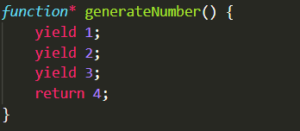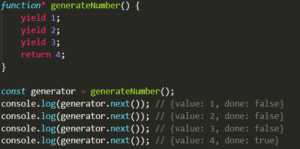If you’ve been a JavaScript developer for some time and heard about ECMAScript 6 (ES6) concepts, then you must have come across generator functions. You might be thinking, what are generator functions? Why do we need it? What problems do they solve?
We can find the answer, but we have to take a step back and reexamine regular functions to understand what a generator function is. All of us have used normal functions in various places. A normal function starts from the very first line of the function, runs until the end until it returns values or last line of function, and returns only one, single value.
What if we want to return multiple values and pause a function execution? It’s possible in JavaScript, and we can achieve this with the help of generator functions.
Key Facts About Generator Functions
A generator function is quite different from normal functions. To create a generator, we will have to use “function*” as the syntax construct.
Providing an “*” after a function keyword indicates you’re creating a generator function. We can write one generator function in the image below:

The image above displays what the definition of a generator function will look like. The “yield” keyword pauses/resumes the generator function and returns the value of the expression to the generator’s caller. Whenever a generator function is called to execute and we try to log its type, it will return the output like this:

A generator function returns a special object called “generator object,” which is a type of iterators. An iterator is an object that defines an iteration sequence (like an Array in JavaScript) and potentially returns a value upon its termination.
How a Generator Function Works
Calling generator functions is not similar to calling normal regular functions. To call a generator function, we will need to call it using the “next()” method. When we call a generator function with the next() method, it will run the execution until the nearest yield “<value>” statement. The value can be omitted, and it will return “undefined.” The function execution is paused, and the yielded value returns to the generator’s caller.
The result of next() is always an object with two properties:
- Value: the yielded value.
- Done: true if the function code is finished else will return false.
Let’s see what the same snippet returns when called with the next() method:

In the image above, the value and done are returned for each “yield” and “return” keyword. With the last statement of function (the return keyword) changing from false to true to indicate that it reached the last statement of a function, the generator function execution must now stop. This is how the generator function is called and values are retrieved from it.
Generator without any return statement:
The generator function will stop the execution without having a return statement in the function. This is how the code will look:
function* generateNumber() {

In the code snippet above, we haven’t returned any values from a generator. Once all yield <value> is resolved, and we call on the next() method, it will then return a value as “undefined” and stops the generator statement execution, and finishes with the value “true.”
Browser Compatibility
Check out the other methods available for generator functions besides the next() method:
- Return(): Returns the given value and finishes the execution of the generator.
- Throw(): Throws an error to a generator and finishes the execution of the generator.
The Basics of Generators
Do we really need generator functions in JavaScript? I think they can be useful whenever we need any data only on demand and don’t want to send data immediately when we execute a function. There are many more use cases when generator functions are useful. For more information about the usage of generator functions, contact our technical experts today.


